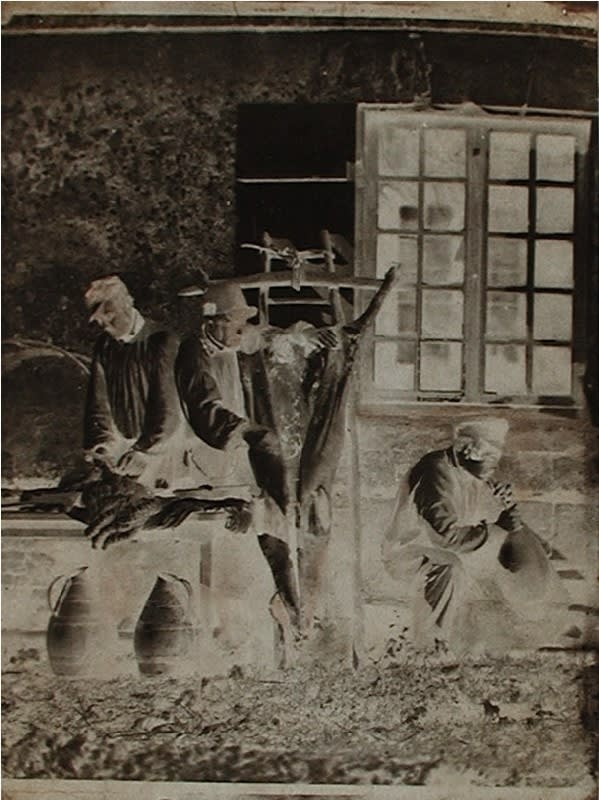Humbert De Molard
Men Dressing a Hog
Waxed Paper Negative
24.5 x 17.8 cms
9 10/16 x 7 1/16 ins
9 10/16 x 7 1/16 ins
1890
The unique, over-painted, paper negative for one of Humbert de Mollard's most famous works. The S.F.P. has a print from this negative which they date 1846. This untrimmed waxed negative...
The unique, over-painted, paper negative for one of Humbert de Mollard's most famous works.
The S.F.P. has a print from this negative which they date 1846.
This untrimmed waxed negative is touched with graphite, ink and varnish.
This tableau of his workers preparing a pig, complete with a servant blowing up a pig's bladder, is directly taken from painting, specifically seventeenth and eighteenth century Dutch genre scenes, an example of which is also in the collection.
Andre Jammes writes that 'In the group of Men Dressing a Hog, 1846, each dfigure concentrates on his task so intently that it turns into timeless ritual ecapsulated and separate from the collective effort. The effect is one of mournful and utter silence in the slanted light and shadow... They inform the style of painting Courbet later in 1850 called realism... Born in the half-light of romantic somnabmbulance, like the hog dressers of Humbert, the torpid creatures of After Dinner at Ornans, 1849, and the ever-silent Stonebreakers, 1851, enlarge Courbet's vision of the universe intoa splended still life in which workers, sleepers, apples and mountains are the interchangeable elements.' (The Art of the French Calotype, pp.20-23)
Clearly attempting to create in photography the type of genre scene he admired in seventeenth-century Dutch painting and its early-nineteenth-century French revival, the wealthy baron and gentleman farmer Humbert de Molard posed his wife, daughter, caretaker, and workers in tableaux of rural life at his chat Argentelle, in Normandy. Among the medium's pioneers in France, having taken up photography in 1843, Humbert de Molard exhibited this triptych at the 1856 Brussels Photographic Exposition as proof that he had made fast exposures and permanent prints even in 1850, when few practiced the art of photography on paper.
Humbert de Molard, freed from financial concerns by the wealth of his landholdings in Normandy and perhaps missing the activity of Paris as he settled in the provincial town of Lagny, took up photography in 1843, just four years after its invention. A clever chemist and skilled craftsman, he quickly mastered the new medium of daguerreotypy and experimented with paper photography by the late 1840s.
The S.F.P. has a print from this negative which they date 1846.
This untrimmed waxed negative is touched with graphite, ink and varnish.
This tableau of his workers preparing a pig, complete with a servant blowing up a pig's bladder, is directly taken from painting, specifically seventeenth and eighteenth century Dutch genre scenes, an example of which is also in the collection.
Andre Jammes writes that 'In the group of Men Dressing a Hog, 1846, each dfigure concentrates on his task so intently that it turns into timeless ritual ecapsulated and separate from the collective effort. The effect is one of mournful and utter silence in the slanted light and shadow... They inform the style of painting Courbet later in 1850 called realism... Born in the half-light of romantic somnabmbulance, like the hog dressers of Humbert, the torpid creatures of After Dinner at Ornans, 1849, and the ever-silent Stonebreakers, 1851, enlarge Courbet's vision of the universe intoa splended still life in which workers, sleepers, apples and mountains are the interchangeable elements.' (The Art of the French Calotype, pp.20-23)
Clearly attempting to create in photography the type of genre scene he admired in seventeenth-century Dutch painting and its early-nineteenth-century French revival, the wealthy baron and gentleman farmer Humbert de Molard posed his wife, daughter, caretaker, and workers in tableaux of rural life at his chat Argentelle, in Normandy. Among the medium's pioneers in France, having taken up photography in 1843, Humbert de Molard exhibited this triptych at the 1856 Brussels Photographic Exposition as proof that he had made fast exposures and permanent prints even in 1850, when few practiced the art of photography on paper.
Humbert de Molard, freed from financial concerns by the wealth of his landholdings in Normandy and perhaps missing the activity of Paris as he settled in the provincial town of Lagny, took up photography in 1843, just four years after its invention. A clever chemist and skilled craftsman, he quickly mastered the new medium of daguerreotypy and experimented with paper photography by the late 1840s.
Provenance
Private collection, FranceRobert Hershkowitz Ltd
Literature
Andre Jammes and Eugenia Parry Janis, The Art of the French Calotype, With a Critical Dictionary of Photograhers, 1845-1870, Princeton NJ; Princeton University Press, (pp. 20-23 pl. 20)Join our mailing list
* denotes required fields
We will process the personal data you have supplied to communicate with you in accordance with our Privacy Policy. You can unsubscribe or change your preferences at any time by clicking the link in our emails.
